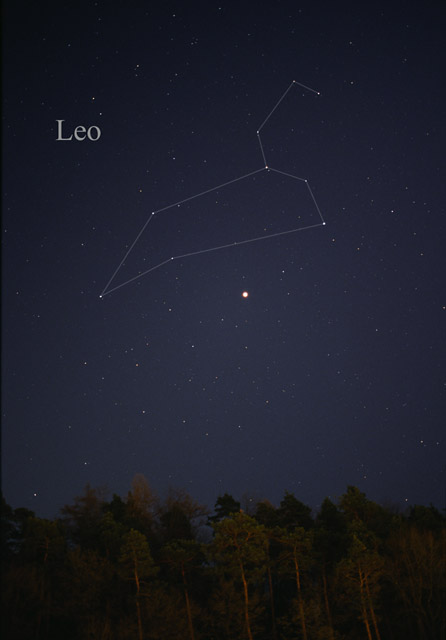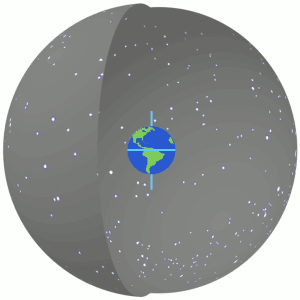|
Denebola
Denebola is the second-brightest individual star in the zodiac constellation of Leo.The two components of the γ Leonis double star, which are unresolved to the naked eye, have a combined magnitude brighter than it. It is the easternmost of the bright stars of Leo. It has the Bayer designation Beta Leonis or β Leonis, which are abbreviated Beta Leo or β Leo. Denebola is an A-type main sequence star with 75% more mass than the Sun and 15 times the Sun's luminosity. Based on parallax measurements from the Hipparcos astrometry satellite, the star is at a distance of from the Sun. Its apparent visual magnitude is 2.14, making it readily visible to the naked eye. Denebola is a Delta Scuti type variable star, meaning its luminosity varies very slightly over a period of a few hours. Nomenclature ''β Leonis'' ( Latinised to ''Beta Leonis'') is the star's Bayer designation. In Johann Bayer's ''Uranometria'' (1603), it was designated β (Beta) as the second-brightest sta ... [...More Info...] [...Related Items...] OR: [Wikipedia] [Google] [Baidu] |
Leo (constellation)
Leo is one of the constellations of the zodiac, between Cancer (constellation), Cancer the crab to the west and Virgo (constellation), Virgo the maiden to the east. It is located in the Northern celestial hemisphere. Its name is Latin for lion, and to the ancient Greeks represented the Nemean Lion killed by the mythical Greek hero Heracles as one of his Twelve Labours, twelve labors. Its old astronomical symbol is (♌︎). One of the 48 constellations described by the 2nd-century astronomer Ptolemy, Leo remains one of the 88 modern constellations today, and one of the most easily recognizable due to its many bright stars and a distinctive shape that is reminiscent of the crouching lion it depicts. Features Stars Leo contains many bright stars, many of which were individually identified by the ancients. There are nine bright stars that can be easily seen with the naked eye, four of the nine stars are either first or second magnitude which render this constellation especially ... [...More Info...] [...Related Items...] OR: [Wikipedia] [Google] [Baidu] |
Chinese Star Names
Chinese star names ( Chinese: , ''xīng míng'') are named according to ancient Chinese astronomy and astrology. The sky is divided into star mansions (, ''xīng xiù'', also translated as "lodges") and asterisms (, ''xīng guān''). The ecliptic is divided into four sectors that are associated with the Four Symbols, guardians in Chinese mythology, and further into 28 mansions. Stars around the north celestial pole are grouped into three enclosures (, ''yuán''). The system of 283 asterisms under the Three Enclosures and Twenty-Eight Mansions was established by Chen Zhuo of the Three Kingdoms period, who synthesized ancient constellations and the asterisms created by early astronomers Shi Shen, Gan De and Wuxian. Since the Han and Jin dynasties, stars have been given reference numbers within their asterisms in a system similar to the Bayer or Flamsteed designations, so that individual stars can be identified. For example, Deneb (α Cyg) is referred to as (''Tiān Jīn S� ... [...More Info...] [...Related Items...] OR: [Wikipedia] [Google] [Baidu] |
Deneb
Deneb () is a blue supergiant star in the constellation of Cygnus. It is the brightest star in the constellation and the 19th brightest in the night sky, with an apparent magnitude slightly varying between +1.21 and +1.29. Deneb is one of the vertices of the asterism known as the Summer Triangle and the "head" of the Northern Cross. Its Bayer designation is α Cygni, which is Latinised to Alpha Cygni, abbreviated to Alpha Cyg or α Cyg. Deneb rivals Rigel, a closer blue supergiant, as the most luminous first-magnitude star. However, its distance, and hence luminosity, is poorly known; its luminosity is estimated to be between 55,000 and 196,000 times that of the Sun. Distance estimates range from 1,400 to 2,600 light-years; assuming its highest value, it is the farthest star with an apparent magnitude brighter than 2.50. Nomenclature ''α Cygni'' (Latinised to ''Alpha Cygni'') is the star's designation given by Johann Bayer in 1603. The traditional name ''De ... [...More Info...] [...Related Items...] OR: [Wikipedia] [Google] [Baidu] |
List Of Stars In Leo
This is the list of notable stars in the constellation Leo (constellation), Leo, sorted by decreasing brightness. See also *List of stars by constellation References * * * {{Stars of Leo Leo (constellation), *List Lists of stars by constellation, Leo ... [...More Info...] [...Related Items...] OR: [Wikipedia] [Google] [Baidu] |
Delta Scuti Variable
A Delta Scuti variable (sometimes termed dwarf cepheid when the V-band amplitude is larger than 0.3 mag.) is a class of pulsating star, comprising several sub-classes of object with A- or F-type spectra. The variables follow a period-luminosity relation in certain passbands like other standard candles such as Cepheids. and, together with classical cepheids, are important standard candles. They have been used to establish the distance to the Large Magellanic Cloud, globular clusters, open clusters, and the Galactic Center. The OGLE and MACHO surveys have detected nearly 3,000 Delta Scuti variables in the Large Magellanic Cloud. Typical brightness fluctuations of Delta Scuti variables are from 0.003 to 0.9 magnitudes in V over a period of a few hours, although the amplitude and period of the fluctuations can vary greatly. They are usually A0 to F5 type giant, subgiant, or main sequence stars. The high-amplitude Delta Scuti variables are also called AI Velorum stars, after ... [...More Info...] [...Related Items...] OR: [Wikipedia] [Google] [Baidu] |
A-type Main Sequence Star
An A-type main-sequence star (A) or A dwarf star is a main-sequence (hydrogen burning) star of spectral type A and luminosity class (five). These stars have spectra defined by strong hydrogen Balmer absorption lines. They measure between 1.7 and 2.1 solar masses (), have surface temperatures between 7,600 and 10,000 K, and live for about a quarter of the lifetime of our Sun. Bright and nearby examples are Altair (A7), Sirius A (A1), and Vega (A0). A-type stars do not have convective zones and thus are not expected to harbor magnetic dynamos. As a consequence, because they do not have strong stellar winds, they lack a means to generate X-ray emissions. Spectral standard stars The revised Yerkes Atlas system listed a dense grid of A-type dwarf spectral standard stars, but not all of these have survived to this day as standards. The "anchor points" and "dagger standards" of the MK spectral classification system among the A-type main-sequence dwarf stars, i.e. th ... [...More Info...] [...Related Items...] OR: [Wikipedia] [Google] [Baidu] |
Hindu
Hindus (; ; also known as Sanātanīs) are people who religiously adhere to Hinduism, also known by its endonym Sanātana Dharma. Jeffery D. Long (2007), A Vision for Hinduism, IB Tauris, , pp. 35–37 Historically, the term has also been used as a geographical, cultural, and later religious identifier for people living in the Indian subcontinent. It is assumed that the term ''"Hindu"'' traces back to Avestan scripture Vendidad which refers to land of seven rivers as Hapta Hendu which itself is a cognate to Sanskrit term ''Sapta Sindhuḥ''. (The term ''Sapta Sindhuḥ'' is mentioned in Rig Veda and refers to a North western Indian region of seven rivers and to India as a whole.) The Greek cognates of the same terms are "''Indus''" (for the river) and "''India''" (for the land of the river). Likewise the Hebrew cognate ''hōd-dū'' refers to India mentioned in Hebrew BibleEsther 1:1. The term "''Hindu''" also implied a geographic, ethnic or cultural identifier for ... [...More Info...] [...Related Items...] OR: [Wikipedia] [Google] [Baidu] |
Al-Biruni
Abu Rayhan Muhammad ibn Ahmad al-Biruni (; ; 973after 1050), known as al-Biruni, was a Khwarazmian Iranian scholar and polymath during the Islamic Golden Age. He has been called variously "Father of Comparative Religion", "Father of modern geodesy", Founder of Indology and the first anthropologist. Al-Biruni was well versed in physics, mathematics, astronomy, and natural sciences, and also distinguished himself as a historian, chronologist, and linguist. He studied almost all the sciences of his day and was rewarded abundantly for his tireless research in many fields of knowledge. Royalty and other powerful elements in society funded al-Biruni's research and sought him out with specific projects in mind. Influential in his own right, al-Biruni was himself influenced by the scholars of other nations, such as the Greeks, from whom he took inspiration when he turned to the study of philosophy. A gifted linguist, he was conversant in Khwarezmian, Persian, Arabic, and Sanskri ... [...More Info...] [...Related Items...] OR: [Wikipedia] [Google] [Baidu] |
Ulugh Beg
Mīrzā Muhammad Tarāghāy bin Shāhrukh (; ), better known as Ulugh Beg (; 22 March 1394 – 27 October 1449), was a Timurid sultan, as well as an astronomer and mathematician. Ulugh Beg was notable for his work in astronomy-related mathematics, such as trigonometry and spherical geometry, as well as his general interests in the arts and intellectual activities.Science in Islamic civilisation: proceedings of the international symposia: "Science institutions in Islamic civilisation", & "Science and technology in the Turkish and Islamic worl/ref> Ulugh Beg, OU Libraries, Britannica Academic It is thought that he spoke five languages: Arabic, Persian, Chaghatai Turkic, Mongolian, and a small amount of Chinese. During his rule (first as a governor, then outright) the Timurid Empire achieved the cultural peak of the Timurid Renaissance through his attention and patronage. Samarkand was captured and given to Ulugh Beg by his father Shah Rukh. He built the great ... [...More Info...] [...Related Items...] OR: [Wikipedia] [Google] [Baidu] |
Right Ascension
Right ascension (abbreviated RA; symbol ) is the angular distance of a particular point measured eastward along the celestial equator from the Sun at the equinox (celestial coordinates), March equinox to the (hour circle of the) point in question above the Earth. When paired with declination, these celestial coordinate system, astronomical coordinates specify the location of a point on the celestial sphere in the equatorial coordinate system. An old term, ''right ascension'' (), "''Ascensio recta'' Solis, stellæ, aut alterius cujusdam signi, est gradus æquatorus cum quo simul exoritur in sphæra recta"; roughly translated, "''Right ascension'' of the Sun, stars, or any other sign, is the degree of the equator that rises together in a right sphere" refers to the ''ascension'', or the point on the celestial equator that rises with any celestial object as seen from Earth's equator, where the celestial equator perpendicular, intersects the horizon at a right angle. It contrasts wi ... [...More Info...] [...Related Items...] OR: [Wikipedia] [Google] [Baidu] |
IAU Working Group On Star Names
The International Astronomical Union (IAU) established a Working Group on Star Names (WGSN) in May 2016 to catalog and standardize proper names for stars for the international astronomical community. It operates under Division C – Education, Outreach and Heritage. The IAU states that it is keen to make a distinction between the terms ''name'' and ''designation''. To the IAU, ''name'' refers to the (usually colloquial) term used for a star in everyday conversation, while ''designation'' is solely alphanumerical, and used almost exclusively in official catalogues and for professional astronomy. (The WGSN notes that transliterated Bayer designations (e.g., Tau Ceti) are considered a special historical case and are treated as designations.) Terms of reference The terms of reference for the WGSN for the period 2016–2018 were approved by the IAU Executive Committee at its meeting on 6 May 2016. In summary, these are to: * establish IAU guidelines for the proposal and a ... [...More Info...] [...Related Items...] OR: [Wikipedia] [Google] [Baidu] |
International Astronomical Union
The International Astronomical Union (IAU; , UAI) is an international non-governmental organization (INGO) with the objective of advancing astronomy in all aspects, including promoting astronomical research, outreach, education, and development through global cooperation. It was founded on 28 July 1919 in Brussels, Belgium and is based in Paris, France. The IAU is composed of individual members, who include both professional astronomers and junior scientists, and national members, such as professional associations, national societies, or academic institutions. Individual members are organised into divisions, committees, and working groups centered on particular subdisciplines, subjects, or initiatives. the Union had 85 national members and 12,734 individual members, spanning 90 countries and territories. Among the key activities of the IAU is serving as a forum for scientific conferences. It sponsors nine annual symposia and holds a triannual General Assembly that sets policy ... [...More Info...] [...Related Items...] OR: [Wikipedia] [Google] [Baidu] |







